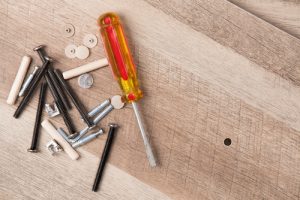Man-made “Worm Holes” in Furniture
By Chris Williams on February 17, 2012.
Q. My wife’s mother gave her a wooden dresser that is fairly new. It has groupings of small, shallow holes in the surface. My wife thinks these are some kind of wood borer holes, but I think they might have been done on purpose by the manufacturer. Have you ever heard of anything like this?
A. Yes, and the process is “distressing!” By that, I mean that distressing furniture or wood paneling is the art of adding the look of age to a piece of wood. Believe it or not, some people want furniture that looks like an instant antique, old and worn, complete with holes and tunnels that look like they were made by wood borers. Distressing is common practice in certain styles of interior decoration such as country, shabby chic, plantation, and some types of British colonial.
 Distressing wood involves everything from beating the surface with a hammer to banging it with a chain. One method even advises refinishers to create the look of fly specks by using a toothpick dipped in black paint! One form of distressing is to create “worm holes” so that the furniture looks like it was infested with borers decades ago. The most common methods for making artificial worm holes are striking the wood with an ice pick, driving a finishing nail into the wood then pulling it out, or using a power drill with a 1/16 inch bit. The drill bit leaves holes that are the same size as the holes made by a certain powderpost beetle. Directions suggest drilling 4 or 5 worm holes grouped in a small cluster to simulate real wood borer emergence holes! When a piece of furniture is distressed, the refinisher rarely stops with worm holes. Look for other signs of distressing such as dents, gouges, paint crackling, chips, scratches, or areas of intentionally worn finish to make the piece look old.
Distressing wood involves everything from beating the surface with a hammer to banging it with a chain. One method even advises refinishers to create the look of fly specks by using a toothpick dipped in black paint! One form of distressing is to create “worm holes” so that the furniture looks like it was infested with borers decades ago. The most common methods for making artificial worm holes are striking the wood with an ice pick, driving a finishing nail into the wood then pulling it out, or using a power drill with a 1/16 inch bit. The drill bit leaves holes that are the same size as the holes made by a certain powderpost beetle. Directions suggest drilling 4 or 5 worm holes grouped in a small cluster to simulate real wood borer emergence holes! When a piece of furniture is distressed, the refinisher rarely stops with worm holes. Look for other signs of distressing such as dents, gouges, paint crackling, chips, scratches, or areas of intentionally worn finish to make the piece look old.
Whether your wife’s dresser is an example of an intentionally distressed piece, or whether they are real borer holes, only an expert can tell. It’s also possible that the holes were from an actual beetle infestation that is no longer active. A pest control professional would be able to inspect the dresser and tell for sure. While a powderpost beetle hole tends to be perfectly round, these artificial beetle holes usually have at least one dull edge where the nail or pick has been pried out. Artificial holes are also usually fairly shallow and are created before the final finish is applied, or are heavily waxed afterwards. In either case, bare wood is not visible around the rim of the holes and the holes will not contain the typical frass or “sawdust” which is present in active beetle infestations.